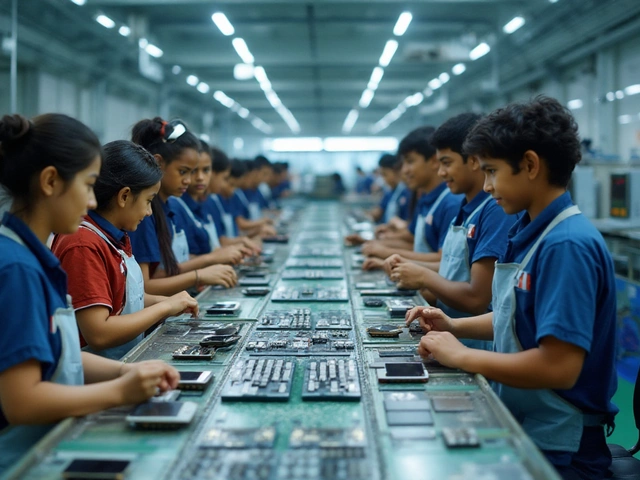India has been making waves in the electronics manufacturing scene, transitioning from being a mere consumer to a formidable producer. The nation's ambition to become a global manufacturing giant is witnessed through concerted efforts in enhancing its infrastructure, policies, and international partnerships.
Several government initiatives have paved the way for this transformation, aiming to position India as a competitive player on the world stage. This article discusses India's global rank in the electronics manufacturing sector and sheds light on the various factors at play, including major investments, partnerships, and the role of policy interventions.
While the path to the top is fraught with challenges, ranging from supply chain complexities to technological gaps, India continues to forge ahead, driven by innovation and resilience.
- Emergence of India as a Manufacturing Hub
- Government Initiatives and Policies
- Key Players and Investments
- Challenges Facing the Industry
- Future Prospects for India
Emergence of India as a Manufacturing Hub
India's journey to becoming a notable player in the electronics manufacturing sector has been nothing short of transformative. A couple of decades ago, the country was largely dependent on imports for most electronic goods, but recent years have seen a dramatic shift. Today, India is not just assembling devices but also manufacturing components, thanks to its growing infrastructure and an influx of foreign investments. One of the key drivers of this transition has been the country's strategic positioning to leverage its large pool of skilled labor, which is not only abundant but also cost-effective compared to other parts of the world.
The emergence of India as a manufacturing hub has been facilitated by government undertakings like the 'Make in India' initiative, which was launched in 2014. This campaign aimed to transform India into a global manufacturing powerhouse by fostering innovation, enhancing skill development, and building best-in-class infrastructure. The program has attracted global giants such as Apple, Samsung, and Xiaomi to either set up their plants or expand existing facilities in India. For instance, Apple's decision to commence manufacturing certain iPhone models locally has demonstrated the potential and readiness of Indian facilities to meet international standards.
According to Tim Cook, CEO of Apple, "India is one of the most important growth markets where we are working with great momentum.
Furthermore, special economic zones (SEZs) across the country have bolstered this endeavor by offering tax incentives, single-window clearances, and other benefits that make it easier for businesses to establish and operate in India. These SEZs have become critical in attracting both domestic and international manufacturers, creating a robust ecosystem for electronics production. The proliferation of startups in electronics design, aided by incubators and government support, has added another layer to this developing ecosystem, promoting research and development in technologies suitable for the Indian market.
Statistics from the India Brand Equity Foundation highlight this growth, stating that the electronics manufacturing industry in India is anticipated to reach $400 billion by 2025. This unprecedented growth can be attributed to the burgeoning demand for electronic products domestically due to rising disposable incomes and a burgeoning tech-savvy population. As a growing market, India offers enormous potential not only for manufacturing but also for consumption, creating a self-sustaining loop that attracts further investment and yields higher economic returns. This burgeoning demand drives scale, which in turn reduces costs and boosts innovation, an essential cycle for any manufacturing hub to thrive.
Challenges do exist, such as infrastructure bottlenecks and regulatory hurdles, but India's upward trajectory in the global electronics manufacturing landscape is a testament to its resilience and strategic foresight. With continued enhancements in logistics and relaxed regulatory frameworks, India is well-positioned to sustain and possibly accelerate its growth. The country's emergence as a global electronics manufacturing hub is not just about volumes and value but also about leading with innovation, sustainability, and inclusivity. This journey, marked by collaboration between the government, industry leaders, and a talented workforce, highlights India as a contender in the global race to dominance in electronics manufacturing.
Government Initiatives and Policies
India's rise as a notable name in electronics manufacturing has been largely attributed to a series of proactive government initiatives and policies. Over the past two decades, the Indian government has prioritized making the country an attractive destination for global manufacturing investments. Initiatives like the 'Make in India' campaign have significantly boosted this sector's visibility and growth potential. By encouraging foreign companies to establish manufacturing units in India, the initiative has not only created jobs but also elevated India's technological capabilities. A major step in this direction was the establishment of special economic zones (SEZs) dedicated to electronics manufacturing, providing a conducive atmosphere for growth, exempt from typical impediments such as burdensome taxation and regulatory hurdles.
An integral part of India's strategy, the Production Linked Incentive (PLI) Scheme, has been designed to promote large-scale domestic manufacturing by providing incentives over a span of five years. This scheme spans various sectors but has a pronounced impact on the electronics industry due to hefty financial allocations aimed directly at companies engaged in producing mobile phones and other electronic components. This not only strengthens India's manufacturing backbone but also positions it as a potential global leader in electronics manufacturing. Indeed, under this framework, companies are encouraged with incentives tied to their production output, thereby linking industrial rewards directly to performance.
Recent statistics highlight the success of such policies. According to the Ministry of Electronics and Information Technology, India's electronic production reached a staggering $75 billion in 2022, a jump from $65 billion the previous year. These figures reflect burgeoning growth fueled by policy-driven strategies. The government has also focused on bolstering research and development within the sector by supporting technology innovation hubs and encouraging public-private partnerships.
As noted by Ravi Shankar Prasad, former Minister of Electronics and Information Technology, "Our effort is to empower the country by reforming current laws and inviting large foreign participation in the Indian electronics ecosystem."
Furthermore, collaborations with other countries have been pivotal. Aligning with global giants like Taiwan and South Korea has ushered in new methodologies and innovation practices that greatly benefit India's manufacturing processes. The strategic collaborations aim to tap into the technological advancements and expertise these countries offer, thus bridging gaps in India's own technology landscape. As a concerted effort, these policies also focus on minimizing imports of critical components by nurturing homegrown industries. India aspires not just to assemble electronics but to create an ecosystem where components are developed within its borders.

Key Players and Investments
The landscape of electronics manufacturing in India has been remarkably reshaped by significant players both from within the country and from international shores. Major technology giants have earmarked India as a focal point for their manufacturing ambitions, a trend catalyzed by India's growing expertise and conducive business environment. Companies like Foxconn, Samsung, and Xiaomi have rooted themselves deeply within India, each contributing to the burgeoning electronics ecosystem. These companies not only bring in financial resources but also share their vast treasure trove of technical expertise, creating an enriched tapestry of innovation and quality.
Foxconn, for one, has committed to expanding its manufacturing facilities significantly. The Taiwanese powerhouse is not only betting big on India's production capabilities but also collaborating with local firms to enhance supply chain robusticity. Samsung, known for its consumer electronics dominance, has unfurled what it claims to be the world's largest mobile manufacturing plant in India. This strategic investment speaks volumes about the increasing trust international firms are placing in Indian soil to meet global demands. Xiaomi, on the other hand, having recognized the immense potential of the vast Indian consumer base, has made substantial advances by establishing multiple manufacturing units across the country while fostering partnerships with local entities.
Investments in the sector are also bolstered by crucial government-led incentives which have evidently attracted fresh players into the market. The government’s Production Linked Incentive (PLI) scheme has been pivotal, offering financial benefits that encourage both existing giants and new entrants to set up shop in India. A recent report highlighted that electronics manufacturing in India witnessed nearly a 5% growth annually, a number that tells a story of potential and promise. An industry expert was quoted as saying,
"India's electronics sector is on an unprecedented trajectory, driven by a unique combination of local talent and global collaborations."
With cumulative efforts from these strong players and the encouragement of strategic investments, the path for electronics manufacturing in India seems well-lit. Support in the form of infrastructural development and financial diligence further strengthens this burgeoning sector. Nevertheless, amidst this positive outlook, the focus remains on sustaining this momentum and addressing any operational hiccups that come along the way.
Challenges Facing the Industry
The journey of India towards establishing a firm footing in electronics manufacturing is not without its hurdles. A significant challenge lies in the fragmented supply chain. Despite advancements, coherent and streamlined supply chain systems are still in development stages. Such fragmentation causes delays and raises costs, hindering India's competitive advantage on a global scale. Additionally, the logistics infrastructure, while rapidly progressing, still grapples with inefficiencies, further complicating matters. This can result in longer lead times and higher operational costs, aspects that deter potential international investors and partners.
Another stumbling block for India's electronics manufacturing sector is the shortage of skilled labor. Although the country boasts a vast pool of talent, bridging the gap between academic learning and industry requirements remains an ongoing task. The emphasis on specialized training programs to equip the workforce with cutting-edge skills is evident, but the pace is slow in many regions. This skills gap leads to a reliance on imported expertise, driving up costs and impacting sustainability. Moreover, technological advancements continue to evolve at a blistering pace, and keeping up requires continuous learning and adaptation, which demands resources and time that must be strategically allocated.
The regulatory environment, while being supportive, can sometimes introduce complexities. Companies often encounter bureaucratic red tape, which can stall projects and reduce the pace of innovation. Ensuring compliance with a myriad of regulations can be a daunting task, especially for new entrants in the market.
According to Rajeev Chandrasekhar, Minister of State for Electronics and IT, "Our mission is to create a trusted environment for businesses. We're consistently working to make our framework more agile to match global standards."This suggests a conscious effort to balance regulations with business needs, but it remains a work in progress that requires constant evolution.
Financial accessibility is another challenge, where smaller enterprises face difficulty in securing adequate funding to scale operations or invest in innovative technologies. While government schemes providing financial incentives exist, the reach and impact of these could be amplified to encourage widespread adoption and benefit smaller players. Overcoming this would not only boost production capabilities but would also lead to a healthier, more balanced industry ecosystem where all players have fair growth opportunities.
Environmental considerations are becoming increasingly critical. E-waste management poses a significant threat, as electronics manufacturing processes generate substantial waste that needs efficient handling. Failing to address this adequately could lead to environmental degradation and health risks, putting a dent in India's aspirations of sustainable growth. Policies targeted at enhancing recycling efforts and implementing stringent disposal standards need strengthening to mitigate these risks.
Interestingly, data indicates that by 2024, India aims to meet 50% of its electronics demand through indigenous production, reducing dependency on imports. However, to achieve this, several obstacles, such as enhancing domestic component manufacturing and R&D capabilities, must be overcome. Building a robust domestic market will not only aid in reaching these targets but also bolster India’s standing in the global electronics manufacturing arena.

Future Prospects for India
As we peer into the horizon of India’s expanding electronics manufacturing industry, several promising trends and developments take center stage. India's journey towards becoming a global manufacturing hub is gaining momentum, backed by a blend of ambition, policy support, and technology adoption. There is a palpable excitement surrounding India, as it aims to significantly boost its share in the $2 trillion global electronics market. This ambition is fueled by the promise of continued foreign investment, infrastructure development, and a strong focus on research and innovation.
One key driver of this optimistic outlook is the government's commitment through initiatives such as the Production Linked Incentive (PLI) scheme, which has already attracted substantial foreign direct investments from leading global players. Under the PLI scheme, the government offers incentives to companies based on their sales of locally manufactured goods, which has substantially increased the local production of mobile phones and other electronic goods.
"India is on track to become a preferred destination for electronics manufacturing," said Ravi Shankar Prasad, the former Minister for Electronics & IT, acknowledging the concerted efforts by the government and industry players.
The potential establishment of over 1,000 electronic manufacturing units is anticipated, contributing to significant job creation and expertise development. **local** talent, in concert with international technology partnerships, is expected to drive the innovation necessary for maintaining competitive manufacturing practices. Additionally, the growing domestic demand, coupled with export opportunities, projects India as a vital player on the global stage. As consumer electronics become more integral to daily life, you'll find India strategically positioned to leverage this demand.
A pivotal focus for India will be sustaining and augmenting its current growth through critical investment in R&D, ensuring that the country not only meets but anticipates technological shifts. Such investment could harness unexpected frontiers in emerging technologies like artificial intelligence, the Internet of Things, and next-gen chip design. India’s burgeoning start-up ecosystem can also play a definitive role, facilitating disruptive innovations and promoting agile business models, thereby enriching the industry landscape.
Moreover, regional cooperation with other Asian giants and the strategic cultivation of bilateral trade agreements postures India to expand its footprint. The mutual benefits of such engagements create a robust ecosystem that fuels economic growth and innovation. This intersection of government incentivization, global partnership, industrial innovation, and domestic capabilities paints an encouraging portrait of India as a rising market force.







Write a comment